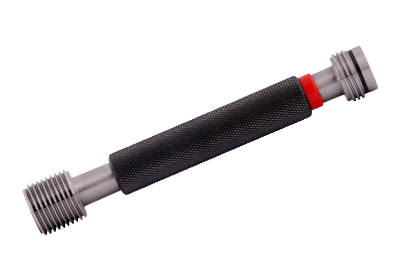What Is a Limit Thread Gauge?

A limit thread gauge is used to check screw dimensions, and is available for both male and female threads. The inspection result is not a numerical value, but a pass/fail judgment based on whether the workpiece thread passes through the gauge or not.
Both for male and female threads, a set of two gauges is used to check both the upper and lower limits of the standard. The inspection points are the effective diameter (thickness of the thread) and outer diameter (diameter at the top of the thread) for male threads, and the effective diameter and inner diameter (diameter at the top of the thread) for female threads. Gauges to check the effective diameter look like screws and are used in combination with workpiece screws.
Inspection gauges are also used to check the wear limits of these gauges.
Uses of Limit Thread Gauges
Limit thread gauges are used by manufacturers and users to check bolts, nuts, and other threaded products.
If the manufactured threads and thumbscrews are within the allowable limit dimensions, interchangeability is ensured in the field of use, even if the manufacturer of each part differs. Conversely, if the screw threads do not fit, the screw threads cannot be assembled, or the tightening strength is insufficient, leading to part breakage.
Inspection gauges are also used to check whether the wear of limit thread gauges exceeds the wear limit. If the limit thread gauge is worn too much, the manufacturer’s and user’s results may differ. To avoid problems, it is important to control the amount of wear of limit thread gauges.
Principle of Limit Thread Gauges
Thread dimensions of limit thread gauges are made to the tolerances specified for each nominal size and grade.
The effective diameter of a thread is the diameter of the hypothetical cylindrical part where the width of the thread peaks and troughs are equal. The gauge used to check the effective diameter is manufactured so that it contacts only the flank (the sloping part of the screw thread that forms the crest and valley) of the workpiece screw, avoiding the top of the crest and the bottom of the valley, so that it is possible to determine if the effective diameter is within the standard.
The outside diameter of a screw is the diameter at the top of the screw thread. Plain ring gauges have a cylindrical inner diameter with no threads and are dimensioned to check the outer diameter of the male thread.
The inside diameter of a female thread is the diameter of the top of the thread. Plain plug gauges have a cylindrical outer diameter without threads and are sized to check the inside diameter of the female thread.
Since limit thread gauges are used by screwing them into the screw to be inspected, they are used in a manner that is prone to wear. Therefore, they are made of hard materials with excellent wear resistance. Gauges are made of bearing steel, alloy tool steel, cemented carbide, etc., depending on the gauge manufacturer. Some gauges are coated with TiN or DLC to improve wear resistance. The appropriate option is selected according to the frequency of inspection and cost.